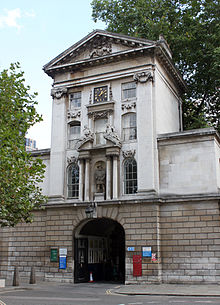Barts Hospital
| St Bartholomew's Hospital | |
|---|---|
| Barts Health NHS Trust | |

(qv. the statue above the arch is the only statue of Henry VIII in London) |
|
| Geography | |
| Location |
Smithfield London, EC1 United Kingdom |
| Organisation | |
| Care system | National Health Service |
| Hospital type | Healthcare and Teaching |
| Affiliated university | Barts and The London School of Medicine and Dentistry |
| Services | |
| Emergency department | No |
| Beds | 388 |
| History | |
| Founded | 1123 |
| Links | |
| Website | / St Bartholomew's Hospital |
St Bartholomew's Hospital, also known simply as Barts and later more formally as The Royal Hospital of St Bartholomew, is a hospital located at Smithfield in the City of London and founded in 1123.
Today it forms part of Barts Health NHS Trust.
Barts was founded in 1123 by Rahere (died 1144, and entombed in the nearby Priory Church of St Bartholomew the Great), a favourite courtier of King Henry I. The Dissolution of the Monasteries did not affect the running of Barts as a hospital, but left it in a precarious position by removing its income. It was refounded by King Henry VIII in December 1546, on the signing of an agreement granting the hospital to the Corporation of London, which was reaffirmed by Letters Patent of January 1547 endowing it with properties and income entitlements.
The hospital became legally styled as the "House of the Poore in West Smithfield in the suburbs of the City of London of Henry VIII's Foundation", although the title was never used by the general public. The first Superintendent of the hospital was Thomas Vicary, sergeant-surgeon to King Henry, and an early writer on anatomy.
It was here that William Harvey conducted his research on the circulatory system in the 17th century, Percivall Pott and John Abernethy developed important principles of modern surgery in the 18th century, and Mrs Bedford Fenwick worked to advance the nursing profession in the late 19th century.
In 1839 to 1872, the mortality reports show that surgical trauma and postoperative infection were the greatest causes of death. Tuberculosis, however, remained the most fatal nontraumatic cause of death.
...
Wikipedia
